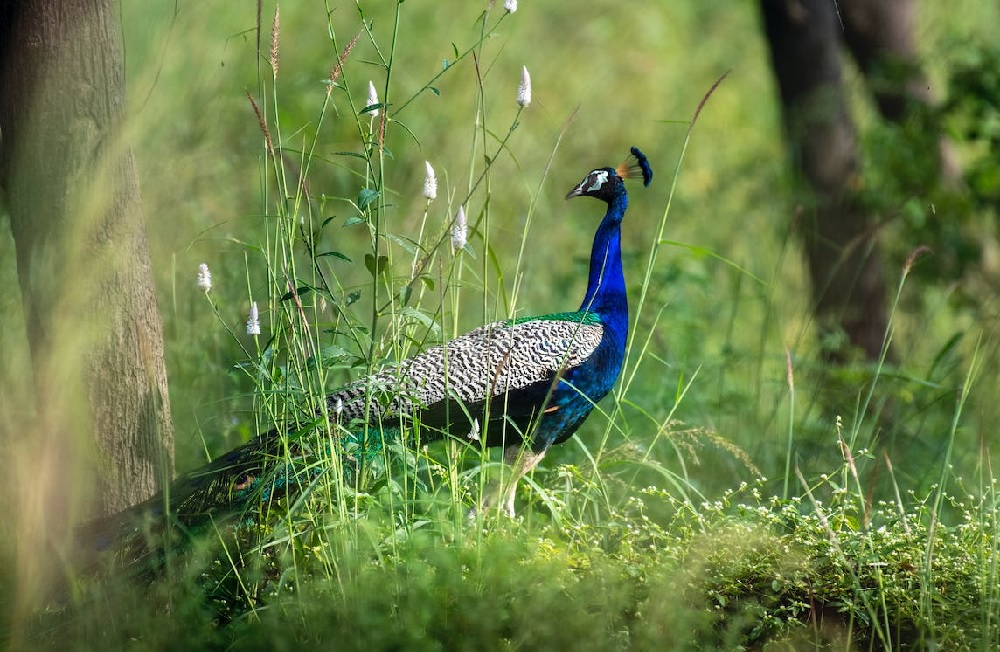The Majestic Peacock: Symbol of Beauty, Grace, and Cultural Significance
Introduction: The peacock, scientifically known as Pavo cristatus, is a captivating and iconic bird that holds a special place in various cultures and mythologies around the world. With its vibrant plumage, distinctive call, and elegant demeanor, the peacock is more than just a creature; it is a symbol of beauty, grace, and cultural significance that has captured the human imagination for centuries.
Physical Attributes and Plumage: The peacock is renowned for its stunning appearance. The male peacock, known as the peafowl, boasts a resplendent fan-like tail composed of iridescent feathers that shine with brilliant shades of blue, green, and gold. This elaborate plumage called a “train,” is used during courtship displays to attract females. The peahen, the female counterpart, has a more modest appearance, with subdued brown and gray feathers that provide effective camouflage.
Cultural Significance:
- Indian Culture: In India, the peacock is deeply intertwined with cultural, religious, and mythological symbolism. It is the national bird of India and holds a revered status in Hinduism, where it symbolizes grace, beauty, and immortality. Lord Krishna, often depicted with a peacock feather adorning his crown, exemplifies the bird’s association with divinity.
- Greek Mythology: In ancient Greek mythology, the peacock was associated with the goddess Hera. Its eyespots on the tail were believed to be the “eyes” of her hundred-eyed servant, Argus, who was transformed into a peacock.
- Persian Culture: The peacock is regarded as a symbol of royalty and nobility in Persian culture. It is often depicted in Persian miniature paintings and is associated with the concept of paradise.
- Early Christianity: In early Christian art, the peacock was a symbol of resurrection and eternal life due to its ability to renew its plumage through molting.
Courtship Displays: The peacock’s courtship displays are among the most mesmerizing sights in the natural world. During the breeding season, the male peacock unfurls his vibrant tail feathers, spreads them into a magnificent fan, and struts before the peahen while emitting a series of calls. This elaborate display of colors, sound, and movement is a testament to the bird’s evolutionary adaptation for attracting mates.
Habitat and Behavior: Peacocks are native to the Indian subcontinent and are found in diverse habitats, including forests, grasslands, and cultivated areas. They are omnivorous birds that feed on insects, plants, seeds, and small vertebrates. While they are known for their striking appearance, they are also skilled runners and fliers.
Conservation Status and Threats: Despite their cultural and aesthetic value, peafowl face several challenges in the wild. Loss of habitat due to urbanization, deforestation, and illegal poaching for their feathers and meat are some of the threats they encounter. Conservation efforts, including protected areas and habitat restoration, are vital for ensuring their survival.
Human-Peacock Interactions:
- Art and Aesthetics: The peacock’s breathtaking beauty has inspired artists, designers, and craftsmen for centuries. Its imagery can be found in paintings, sculptures, textiles, and jewelry.
- Symbol of Beauty: The peacock’s beauty has influenced fashion trends, interior design, and even the naming of colors (“peacock blue” or “peacock green”).
- Tourist Attractions: In countries like India, peacocks are a common sight in parks, gardens, and historical sites. They contribute to the tourism industry by attracting visitors eager to witness their displays.
Conclusion: The peacock’s allure extends beyond its stunning appearance; it embodies cultural significance, mythological symbolism, and natural wonder. Its magnificent plumage, courtship displays, and representation in various traditions highlight the deep connection between humans and the natural world. As we admire the beauty of the peacock, let us also recognize the importance of conserving its habitats and ensuring its survival for generations to come.

